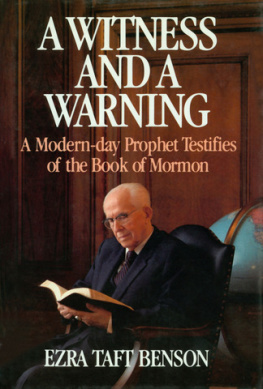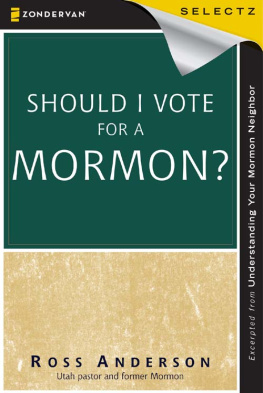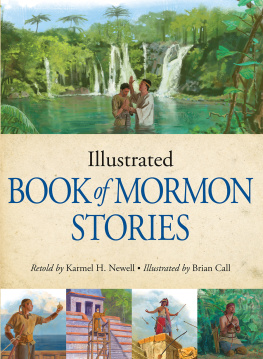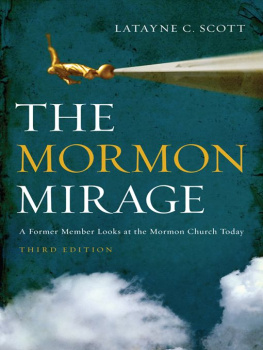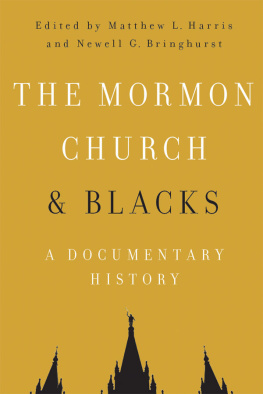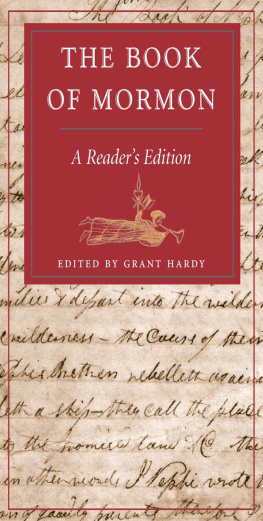Contents
An Insiders View of
Mormon Origins
AN INSIDERS VIEW OF
MORMON ORIGINS
Grant H. Palmer

Signature Books
Salt Lake City, Utah
In loving memory of my wife,
Kathy Dahlin Palmer,
1944-92
Copyright 2002 by Grant H. Palmer. All rights reserved.
Digital scans by Tyson Stokes.
Illustrations of Joseph Smith dictating the Book of Mormon by Kurt Gray.
Cover design by Ron Stucki.
The cover includes, in the background, a selection of books available in
Joseph Smiths youth.
An Insiders View of Mormon Origins was printed on acid-free paper and
was composed, printed, and bound in the United States of America.
2014 2013 2012 2011 16 15 14 13 12 11
Library of Congress Cataloging-in-Publication Data
Palmer, Grant H.
An insiders view of Mormon origins / by Grant H. Palmer
p. cm.
Includes bibliographical references and index.
ISBN 1-56085-157-0 (pbk.)
1. Mormon Church--History--19th century. I. Title
BX8611 .P32 2002
289.3034--dc21
2002030201
Contents
Preface vii
1. Joseph Smith as a Translator/Revelator 1
2. Authorship of the Book of Mormon 39
3. The Bible in the Book of Mormon 69
4. Evangelical Protestantism in the Book of Mormon 95
5. Moroni and The Golden Pot 135
6. Witnesses to the Golden Plates 175
7. Priesthood Restoration 215
8. The First Vision 235
Conclusion 259
Selected Bibliography 265
Index 69
Preface
For thirty-four years I was primarily an Institute director for the Church Educational System (CES) of the Church of Jesus Christ of Latter-day Saints. There is much to like about the college-level discussions that sometimes occur in the Institute setting. Unfortunately, our adult lessons and discussions at church rarely rise above the seminary level, even though many of our members are well educated. Our discussions are usually an inch deep and a mile wide as they say. We seem to have a lingering desire for simple religion. We like to hear confirmations that everything is as we assumed it was: our pioneer ancestors were heroic and inspired and the Bible and Book of Mormon are in perfect harmony, for instance. We never learn in church that the Book of Abraham papyri were discovered and translated by Egyptologists or that researchers have studied Native American genes and what the implications are for the Book of Mormon. Questions about such topics are discouraged because they create tension; they are considered inappropriate or even heretical. This approach has isolated many of us from the rest of the world or from reality itself in those instances when we insist on things that are simply untrue.
All the while, such remarkable research has been conducted over the past thirty years into Mormon origins. It is exciting to see what has been done collaboratively by church historiansthe faculty of the Joseph Fielding Smith Institute for Church History at Brigham Young University, BYU history and religion professors and scholars from other disciplines and other church schools, and seminary and institute facultyand by unaffiliated scholars. Together, they have painstakingly collated and compared accounts of the most important events in church history from the original minutes and diaries; gathered data from the environment to better understand the circumstances under which activities occurred; studied the language of the revelations and scriptures and compared it to the general idiom and to literary expressions; excavated and restored sites; scoured archives; translated documents; gathered genealogical records and pursued traces of peoples lives for additional testaments. They have published, critiqued, and reevaluated a veritable mountain of evidence. Too much of this escapes the view of the rank-and-file in the church.
There was a day when Latter-day Saint history was considered unworthy of this kind of attention by professional historians. In large part, due to the Mormon History Association and the involvement by LDS scholars in other professional groups, this is no longer the case. Today, publishers, both academic and general interest presses, accept and publish Mormon topics on a regular basis. Yet the relatively modest print runs these books usually receive indicate that they sell mostly to other professionals rather than to the LDS public at large. There is a lingering distrust of anything that hasnt come directly from, or with an endorsement by, the church leadership.
Some of this research has been conducted by critics of the church. Some of it contains distortions and is unreliable. But much of what even the critics have written is backed by solid investigation and sound reasoning and should not be dismissed. Your friends dont always tell you what you need to hear. Furthermore, it is untrue that non-Mormons who write about the church are de facto anti-Mormon. Many outside historians are good friends and supporters of the church, and many find the topics interesting for their own sake without any agenda.
About a decade and a half ago, there was some consternation and confusion over Mark Hofmanns forgeries and murders. In fact, it has taken a while to sort through and correct the damage he caused. Ironically, while the LDS church supported the forgeries, two of the churchs most visible critics never accepted their validity. Despite the setback to history caused by Hofmann, the ranks of honest and earnest historians have continued their research and writing.
Over the years, scholars of all stripes have made contributions and counterbalanced each other by critiquing each others works. We now have a body of authentic, reliable documents and a near-consensus on many of the details. From this base, the overall picture of Mormon origins begins to unfold. This picture is much different from what we hear in the modified versions that are taught in Sunday school. But demythologizedplaced in its original time and place, amid all the twists and turns that exist in the real worldit rings true. There has not been an attempt to eliminate the spiritual from the secular. Far from that, the foundational stories are in many cases more spiritual, less temporal, and more stirring. Whatever else, they are also fascinating. To know the personalities involved in these events and to hear them tell their experiences in their own original words before everything was recast for hierarchical and proselyting purposes is to see it all in an entirely new and exciting perspective.
That said, I have wondered how I should introduce my work. How should I convey what I feel in my soul? First, this book is not intended for children or investigators. So much of our attention is directed toward children and potential converts that long-standing adult members rarely have an opportunity to speak freely to each other. We worry that tender ears may overhear. I am a fourth-generation Mormon, and I want to address this discussion to other second-, third-, and fourth-generation Mormons who will better understand where I am coming from. Lest there be any question, let me say that my intent is to increase faith, not to diminish it. Still, faith needs to be built on truthwhat is, in fact, true and believable. After that comes the great leap. We too often confuse faith with knowledge. Faith has to do with the unknown, not about what can be proven or can be shown to be reasonably based on the evidence. I have always thought that an unwillingness to submit ones beliefs to rigorous scrutiny is a manifestation of weakness of faith. Otherwise, everything becomes a matter of orthodoxy rather than truth.
These are matters that I wrestled with for years. As a young man, I became involved in CES because of my commitment to the gospel and my love of the scriptures and also because of my passion for church history. These remain priorities today. I see a number of things differently now than I did before I embarked on this lifelong study of, and service to, the church. I volunteered toward the end of my career to be the LDS Institute director at the Salt Lake County jail. I looked forward to focusing on basic Bible teachings and doing some counseling. I also hoped that I might resolve some of my own questions in an atmosphere where I could freely contemplate them. Now that I am retired, I find myself compelled to discuss in public what I pondered mostly in private at that time.



